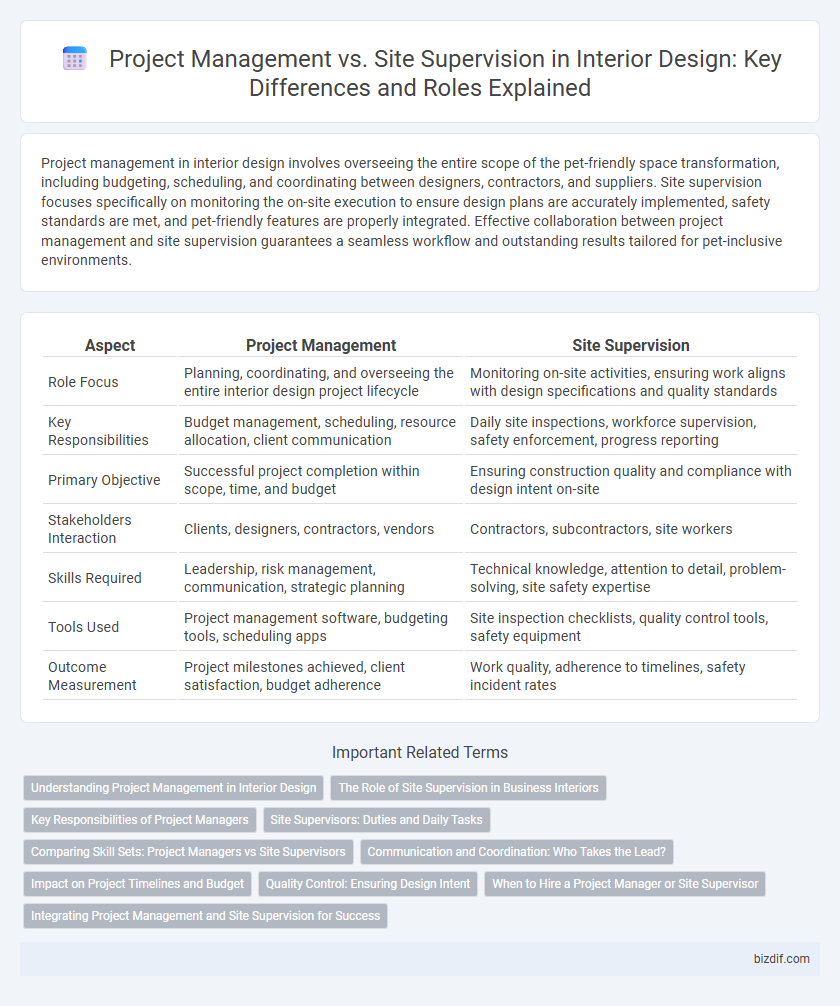Project management in interior design involves overseeing the entire scope of the pet-friendly space transformation, including budgeting, scheduling, and coordinating between designers, contractors, and suppliers. Site supervision focuses specifically on monitoring the on-site execution to ensure design plans are accurately implemented, safety standards are met, and pet-friendly features are properly integrated. Effective collaboration between project management and site supervision guarantees a seamless workflow and outstanding results tailored for pet-inclusive environments.
Table of Comparison
| Aspect | Project Management | Site Supervision |
|---|---|---|
| Role Focus | Planning, coordinating, and overseeing the entire interior design project lifecycle | Monitoring on-site activities, ensuring work aligns with design specifications and quality standards |
| Key Responsibilities | Budget management, scheduling, resource allocation, client communication | Daily site inspections, workforce supervision, safety enforcement, progress reporting |
| Primary Objective | Successful project completion within scope, time, and budget | Ensuring construction quality and compliance with design intent on-site |
| Stakeholders Interaction | Clients, designers, contractors, vendors | Contractors, subcontractors, site workers |
| Skills Required | Leadership, risk management, communication, strategic planning | Technical knowledge, attention to detail, problem-solving, site safety expertise |
| Tools Used | Project management software, budgeting tools, scheduling apps | Site inspection checklists, quality control tools, safety equipment |
| Outcome Measurement | Project milestones achieved, client satisfaction, budget adherence | Work quality, adherence to timelines, safety incident rates |
Understanding Project Management in Interior Design
Project management in interior design involves comprehensive coordination of resources, timelines, budgets, and client expectations to ensure seamless execution from concept to completion. This process requires strategic planning, risk management, and effective communication with contractors, suppliers, and stakeholders to maintain quality standards and project objectives. Understanding project management enables interior designers to optimize workflows, mitigate delays, and deliver innovative, functional spaces within agreed constraints.
The Role of Site Supervision in Business Interiors
Site supervision in business interiors ensures that design plans are accurately executed, quality standards are maintained, and timelines are strictly followed. This role involves coordinating subcontractors, managing on-site issues, and ensuring compliance with safety regulations to deliver functional and aesthetically pleasing workspaces. Effective site supervision reduces costly reworks and enhances client satisfaction by translating design concepts into reality.
Key Responsibilities of Project Managers
Project managers in interior design oversee the entire project lifecycle, from initial client consultations and budget planning to the coordination of design teams and contractors. They ensure that timelines are met, resources are allocated efficiently, and project goals align with client expectations. Integral responsibilities include risk management, quality control, and maintaining clear communication across all stakeholders to deliver a seamless and successful interior design execution.
Site Supervisors: Duties and Daily Tasks
Site supervisors in interior design oversee on-site execution, ensuring construction aligns with design specifications and quality standards. Their duties include coordinating with contractors, monitoring progress, managing materials and schedules, and addressing any on-site challenges promptly. Daily tasks involve site inspections, verifying safety compliance, and communicating updates to project managers and clients.
Comparing Skill Sets: Project Managers vs Site Supervisors
Project managers in interior design excel in strategic planning, budgeting, and client communication, ensuring timely delivery and resource allocation. Site supervisors possess technical expertise in construction processes, quality control, and on-site problem solving, maintaining safety standards and workflow efficiency. Both roles require leadership and coordination, but project managers prioritize overall project execution while site supervisors focus on daily operational management.
Communication and Coordination: Who Takes the Lead?
In interior design, project management takes the lead in communication and coordination by setting clear objectives, timelines, and stakeholder expectations. Site supervision focuses on real-time issue resolution and ensuring the execution aligns with the design vision and project plan. Effective collaboration between both roles enhances workflow efficiency and prevents costly miscommunications during project delivery.
Impact on Project Timelines and Budget
Effective project management ensures streamlined scheduling, resource allocation, and risk mitigation, directly reducing delays and budget overruns in interior design projects. Site supervision focuses on on-the-ground quality control and adherence to timelines, preventing costly rework and ensuring materials and workmanship meet project standards. Both roles critically influence project timelines and budgets, with project management overseeing overall strategic execution while site supervision handles daily operational efficiency.
Quality Control: Ensuring Design Intent
Project management in interior design focuses on coordinating resources, timelines, and budgets to maintain the overall project quality, ensuring the design intent is met from conception to completion. Site supervision plays a critical role in quality control by monitoring on-site activities, verifying materials, and workmanship align precisely with design specifications. Both functions collaborate to prevent deviations, achieve aesthetic goals, and uphold the functional requirements of the interior space.
When to Hire a Project Manager or Site Supervisor
Hire a project manager when overseeing complex interior design projects involving multiple contractors, tight deadlines, and budget constraints to ensure seamless coordination and timely delivery. Opt for a site supervisor during the construction or renovation phase to monitor daily activities, enforce quality standards, and address on-site issues promptly, maintaining project alignment with design specifications. Effective delegation between project management and site supervision optimizes workflow efficiency and minimizes costly errors.
Integrating Project Management and Site Supervision for Success
Effective integration of project management and site supervision in interior design ensures seamless coordination between planning, procurement, and on-site execution, minimizing delays and cost overruns. Leveraging project management tools like Gantt charts alongside real-time site supervision enhances quality control and adherence to design specifications. This collaborative approach aligns stakeholders, optimizes resource allocation, and drives project completion within budget and schedule constraints.
Project Management vs Site Supervision Infographic

 bizdif.com
bizdif.com